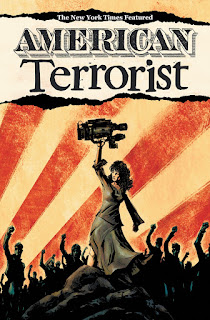Owen is an investigative reporter, focusing primarily on social causes. In particular, he's been working on studying left-wing extremist groups that use very destructive tactics to get their messages across. Kind of like The Weathermen. His friend Michael is a lawyer who mostly represents the disenfranchised, particularly those who've been picked up in black ops government raids and there's precious little information about where they are or what laws they're supposed to have broken. Hannah is a grade school teacher who's frustrated by curriculum standards testing that tends to negate actual teaching, and she struggles with some ill-defined mental issues that her psychologist has prescribed drugs for. Finally, we have Shannon, a research scientist at the EPA whose boss is actively re-writing her report findings for political reasons.
Through a confluence of circumstances, Hannah is falsely accused of threatening to blow up some insurance offices and, in the ensuing confusion, Owen accidentally kills a federal agent. They flee in a panic with Shannon and wind up at Mike's offices. Despite recognizing their innocence, Mike helps them escape and they hook up with some of Owen's contacts for shelter and guidance. The four, now on the run from another dogged FBI agent, begin to pick up the extremist tactics and use the internet to showcase some of the moral injustices committed by large corporations. Both their stunts and the FBI's efforts in capturing them escalate to the point where the FBI is willing to blow up the National Mall during a protest consisting of thousands just to end Owen's influence.
Although the trade paperback only just came out from A Wave Blue World, the original series it reprints is from about a decade ago. Writers Tyler and Wendy Chin-Tanner started working on the idea during the George W. Bush administration, and artist Andy MacDonald came on board soon after Barack Obama became president. I don't recall hearing about this title back then, and I didn't learn of its origins until after having read the story itself. I feel that's an important piece of context that I want to call out though. (For the record, the TPB does make it clear the story is about a decade old; I just opted to skip the Foreword and the back matter until later.)
The reason I feel it's critical to mention that is because the story feels a bit out of time here in 2020. Not that it's irrelevant but the past four years have shifted the context pretty radically, I think. In American Terrorist, corporations are evil and there's a single government agency dedicated to following the rules regardless of who gets harmed in the process, just so long as justice is served according to the law. And while corporations are still evil, they're not as evil and corrupt as the entire federal government, which doesn't give a shit about the rules so long as they get what they want and everyone else can just fuck off. In that sense, American Terrorist feels almost quaint.
The story is interesting enough, and the art is well done, but I did have to question the transition of the characters' shift to militant extremism. Owen makes the most sense, since he's established as being partially embedded with those types of people anyway. Hannah is suggested to be a little off-kilter mentally and that's used as justification for her involvement, a tact that I took a bit of an exception to. Seems like a kind of hand-wave over her motivation, and pretty dismissive of mental illnesses generally. Mike's and Shannon's involvement is quite dubious, though. It's kind of suggested they both get caught up in the moment initially and go along with running, but neither are given a second of self-reflection. Mike in particular, as a lawyer, seems like he should stop at least once to say, "Hey, maybe I can get us out of this hot water legally?" He sort of does once they're literally surrounded by armed agents, but that's only after seemingly weeks or even months on the run and he only suggests that to the agents, never to Owen, Hannah, or Shannon. All of them are just all-in on terrorist tactics pretty much from jump. Also, while the art suggests they attack their targets when places are deserted, there's never any discussion about even the potential for casualties; their first act is blowing up a smokestack -- even if you didn't think someone would get caught in the blast itself, I think you'd understand 500 feet of concrete and steel has to fall somewhere and could pose some imminent danger to anyone remotely nearby!
It's an interesting read, and worth considering for how and why certain tactics for trying to move the needle on social and ecological reforms are or aren't appropriate. Right this second, here in 2020, it seems a little dated -- even with the weekend announcement of President-elect Biden -- but I'm hoping that in six months time, though, it will seem considerably less so.
American Terrorist Review
By Sean Kleefeld | Monday, November 09, 2020
Leave a Comment







0 comments:
Post a Comment